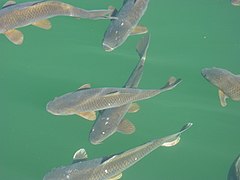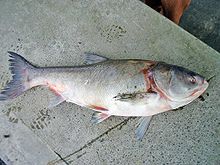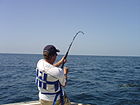Carp fishing

Carp is a common name for various species of freshwater fish of the family Cyprinidae, a very large group of fish native to Europe and Asia. They have been introduced to various locations around the world, though with mixed results.
Carp are variable in terms of angling value. In Europe, even when not fished for food, they are eagerly sought by anglers, being considered highly prized coarse fish that are difficult to hook.[1] In the United States, the carp is also classified as a rough fish as well as damaging naturalized exotic species but with sporting qualities. Many states' departments of natural resources are beginning to view the carp as an angling fish instead of a maligned pest. Groups such as the Carp Anglers Group[2] and American Carp Society[3] promote the sport and work with fisheries departments to organize events to introduce and expose others to the unique opportunity the carp offers freshwater anglers. The American Carp Society held a tournament in March of 2006 in Austin, Texas that paid out $275,000 to the winners.
The UK has a thriving carp angling market. It is the fastest growing angling market in the UK and has spawned a number of specialised carp angling publications such as 'advanced carp fishing', 'carpworld' and 'TotalCarp'.
Izaak Walton said about carp in The Compleat Angler, "The Carp is the queen of rivers; a stately, a good, and a very subtil fish; that was not at first bred, nor hath been long in England, but is now naturalised."[4]
Eating habits

Popular baits include canned corn and homemade doughball concoctions in the USA. In the UK and Europe anglers commonly use a bait known as boilies, which are made from milk proteins, eggs and artificial flavors, these are then boiled in water hence the name boilies.
However, in some countries, due to their habit of grubbing through bottom sediments for food and consequential alteration of their environment, they destroy, uproot and disturb submerged vegetation causing serious damage to native duck and fish populations. In Australia there is anecdotal and mounting scientific evidence that introduced carp are the cause of permanent turbidity and loss of submerged vegetation in the Murray-Darling river system, with severe consequences for river ecosystems, water quality and native fish species.
Common carp

The common carp, or European carp, are native to Asia and Eastern Europe.[5] They have been introduced, sometimes illegally, into environments worldwide, and is often considered an invasive species.
Common carp are very tolerant of most conditions, though they prefer large bodies of slow or standing water and soft, vegetative sediments. A schooling fish, they prefer to be in groups of 5 or more. They natively live in a temperate climate in fresh or brackish water with a 7.0 - 9.0 pH, and an a temperature range of 35.0 - 85.0 °F.
Common carp are extremely popular with anglers in many parts of Europe, and their popularity is slowly increasing among anglers in the United States (though destroyed as pests in many areas). Carp are also popular with spear and bow fisherman. They can grow to a length of 5 feet (1.5 m), a weight of over 80 lb (37.3 kg), and an oldest recorded age of at least 65 years. [citation needed] The largest recorded carp, caught by an angler in 2007 at Rainbow lake near Bordeaux, France, weighed 88.6 pounds (40.1 kilograms).[6] The wild, non-domesticated forms tend to be much less stocky at around 20% - 33% the maximum size.
Silver carp

Silver carp are filter feeders, and thus are difficult to catch on typical hook and line gear. Special methods have been developed for these fish, the most important being the "suspension method" [7] usually consisting of a large dough ball that disintegrates slowly, surrounded by a nest of tiny hooks that are not embedded in the bait. The entire apparatus is suspended below a large bobber. The fish feed on the small particles that are released from the dough ball and will bump against the dough ball, with the intention of breaking off more small particles that can be filtered from the water, eventually becoming hooked on the tiny hooks.
In some areas, it is also legal to use "snagging gear" in which large, weighted treble hooks are jerked through the water, to snag the fish. In the United States, silver carp are also popular targets for bowfishermen; they are shot both from the water and from the air. In the latter case, boats are used to scare the fish and entice them to jump, and the fish are shot from the air when the fish jump.
Bighead carp

Although bighead carp reach large size, they are difficult to capture with a rod and reel because of their filter-feeding habits. They may be captured by the "suspension method" used to catch silver carp, or, where legal, by snagging them by jerking a weighted treble hook through the water. Bighead carp cannot be shot from the air like silver carp, because, unlike the silver carp, they do not jump from the water in response to moving boats. However, they often feed near the surface where they can be shot by bowfishers. The bowfishing record, captured in the Mississippi River near Alton, Illinois in May 2008, is 92.5 lb (42 kg).[8]
Carp bream

The carp bream's home range is in Europe north of the Alps and Pyrenees, as well as in the Balkans. It is also found as far east as the Caspian Sea, the Black Sea, and the Aral Sea. In the UK they are known simply as bream. The carp bream is usually 30 to 55 centimeters (12 to 20 inches) long, though some specimens have been as long as 75 cm (30 in.), and weighed two to four kilograms (four to nine pounds).[9]
The carp bream generally lives in rivers (especially in the lower reaches) and in nutrient-rich lakes and ponds with many algae and muddy bottoms. It can also be found in brackish sea waters. It lives in schools near the bottom. At night carp bream can feed close to the shore and in clear waters with sandy bottoms the feeding pits can be seen during daytime. The carp bream eats chironomidae larvae, tubificidae, bivalves and gastropods as well as aquatic plants and plankton.
Crucian carp

Crucian carp inhabit lakes, ponds, and slow-moving rivers throughout Europe and Asia. They rarely exceeds a weight of over 3.3 pounds (1.5 kg). They are often caught as a sport fish: the British rod-caught record for largest crucian is four pounds, nine ounces, caught by Martin Bowler in a lake in southern England in 2003. There have been various bids for a breakage of this record since, but they have been passed off as the specimens have not been said to have been "true" crucians, but hybrids between the carp and one of its relatives, such as the goldfish, which are not native to the British Isles. These hybrids often exhibit hybrid vigour or heterosis, being much more adept at finding food and evading predators than either of their parents, and thus pose somewhat of a threat to the native carp population, and to other native aquatic animals.
Tench

The tench, or doctor fish, is a freshwater and brackish water fish found throughout Eurasia from Western Europe including the British Isles east into Asia as far as the Ob and Yenisei Rivers. It is also found in Lake Baikal.[10] It normally inhabits slow-moving freshwater habitats, particularly lakes and lowland rivers.[11] It is most often found in still waters with a clay or muddy substrate and abundant vegetation.[1] Tench feed mostly at night on algae and benthic invertebrates of various kinds that they root up from the bottom.[1] This species is rare in clear waters across stony ground, and is absent altogether from fast-flowing streams. It tolerates water with a low oxygen concentration,[10] even being found in waters where the carp cannot survive.[1]
Tench are an important target for coarse anglers.[10] Maximum size is 70 cm, though most specimens are very much smaller.[12] They take a variety of baits but are "nibblers" and are difficult to hook. Fish over 1 kg (2 lb) in weight are very strong fighters when caught on a rod.[13]
Notes
- ^ a b c d A. F. Magri MacMahon (1946). Fishlore, pp 149-152. Pelican Books. Cite error: The named reference "Fishlore" was defined multiple times with different content (see the help page).
- ^ Carp Anglers Group
- ^ American Carp Society
- ^ The Compleat Angler
- ^ Panek, F.M. 1987. Biology and ecology of carp, Pages 1-16 In Cooper, E.L. (editor) Carp in North America. American Fisheries Society, Bethesda, Maryland, USA.
- ^ Angler catches world's biggest carp - which weighs almost as much as Kylie | Mail Online
- ^ Kolar et al. 2007. Bigheaded Carps: Biological Synopsis and Environmental Risk Assessment. American Fisheries Society, Bethesda, MD.
- ^ Bighead carp bowfishing record
- ^ Froese, Rainer; Pauly, Daniel (eds.). "Abramis brama". FishBase. March 2006 version.
- ^ a b c Froese, Rainer; Pauly, Daniel (eds.). "Tinca tinca". FishBase. May 2007 version.
- ^ B. Whitton (1982). Rivers, Lakes and Marshes p 163. Hodder & Staughton, London.
- ^ G. Sterba (1962). Freshwater Fishes of the World pp 249-250. Vista Books, London.
- ^ A. Lawrence Wells (date unknown). Observer Book of Freshwater Fishes, pp 101-103. Frederick Warne & Co.



